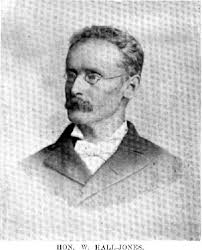

1851 - 1936
William Hall-Jones was an
interim prime minister who filled the narrow gap between the death of Seddon and
the widely expected appointment of his deputy Joseph Ward. Nobody, least of all
Hall-Jones himself, was under any illusions over the temporary nature of his
brief ministry.
The reason for the
interregnum was the absence from New Zealand of both the prime minister and his
deputy in June 1906. Seddon was in Australia facing a strenuous schedule despite
the trip officially designated a “rest cure”; Ward departed for Rome in February
to attend an international postal union congress in his capacity as NZ
postmaster-general. On Seddon’s departure Hall-Jones was asked to become acting
prime minister, a role he accepted reluctantly as one other cabinet member
(James Carroll) was senior to him.
When Seddon died suddenly on
board ship while returning to New Zealand on 10 June, Hall-Jones continued as
acting PM while constitutional issues were resolved by the governor-general Lord
Plunkett and the attorney-general Albert Pitt. It was agreed by all parties that
Hall-Jones should be appointed prime minister but should hold the position only
until Joseph Ward returned to parliament. Hall-Jones did not wish that condition
to be attached to his appointment but voluntarily undertook to resign on Ward’s
return, publicly stating his intention.
Under those rather bizarre
circumstances he assumed the mantle of prime minister on 21 June, 1906. He took
over all of Seddon’s portfolios and left all the other ministers in their
previous roles.
Hall-Jones was first elected
to parliament in a by-election in August, 1890, representing Timaru. He narrowly
retained the seat in the December, 1890 general election and held it
continuously until 1908 when he retired from parliament. Seddon appointed him
minister of public works in 1896 and minister of marine a few months later.
Hall-Jones was a likeable
man with a strong sense of integrity along with a fiercely independent mindset.
He was a conscientious and methodical administrator and highly valued by Richard
Seddon. He had joined the Liberal party under John Ballance and served as party
whip until 1893 but then became an independent member in protest over his
party’s inaction over two specific issues (land division and women’s suffrage).
He rejoined the party after entering cabinet in 1896.
Joseph Ward returned to New
Zealand on 2 August 1906 and after further discussions with the governor-general
and Hall-Jones it was agreed that Ward would take over as prime minister as soon
as he had finalised his cabinet appointments. Thus, on 6 August Hall-Jones
resigned his position. He had been prime minister for 46 days.
In his last two years in
parliament (1906-1908) minister of railways was added to his public works
portfolio and he oversaw two major projects: the completion of the North Island
main trunk railway (two large viaducts and the Raurimu spiral), and the Otira
rail tunnel.
He remained active
politically after resigning from parliament in 1908. He was immediately
appointed high commissioner to Britain and represented New Zealand at several
international congresses and committees. He was knighted in 1910. In 1913 he
returned from his high commission posting and was immediately appointed to the
legislative council, a position he occupied until his death in 1936.
He is interred in Karori
cemetery in Wellington.